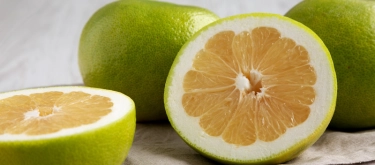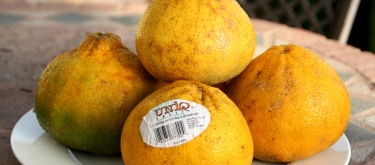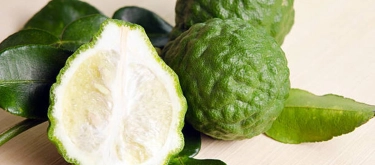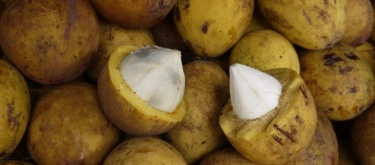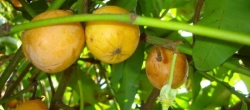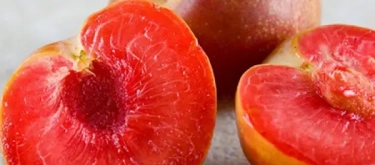MeloGold: Taste Profile, Aroma, Benefits and Health Risks
MeloGold (Citrus paradisi × Citrus maxima) is a unique citrus hybrid developed in California by crossing a pomelo with a grapefruit. Known for its sweetness and reduced bitterness compared to standard grapefruit, MeloGold has gained popularity as a mild and flavorful alternative among citrus enthusiasts. Its appealing taste and juicy flesh make it suitable for fresh consumption, juices, and various culinary applications.
MeloGold is generally safe; however, those with citrus allergies should exercise caution. Due to its moderate acidity, excessive consumption may cause irritation in individuals with gastritis, acid reflux, or stomach ulcers. Safe for moderate consumption during pregnancy.
What does MeloGold taste like?
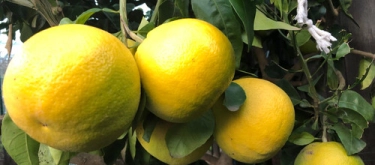
Complete Sensory Description:
Taste
MeloGold offers a pleasantly sweet flavor with mild, balanced acidity, significantly less bitter than traditional grapefruit. Its taste features subtle citrusy notes, complemented by gentle hints of tropical fruits and melon-like sweetness.
Aroma
Its aroma is fresh, mildly citrusy, and slightly floral, characterized by delicate grapefruit-like scents combined with faint melon and honey undertones.
Texture
The fruit’s rind is thick yet easy to peel, revealing juicy, tender segments inside. The pulp is refreshingly succulent, soft-textured, and contains minimal seeds, enhancing its appeal for fresh eating.
Appearance
MeloGold fruits are large, typically measuring 10–15 cm in diameter. They possess smooth, bright yellow-green to golden-yellow skin when fully ripe, with pale-yellow or translucent, juicy inner flesh.
In-depth Flavor Analysis:
MeloGold’s appealing sensory profile results from a harmonious combination of sugars, mild organic acids, minimal bitterness, and aromatic compounds:
-
Sweetness and Acidity: MeloGold’s sweetness is primarily due to sucrose and fructose, harmoniously balanced by mild levels of citric acid. This results in a sweet yet refreshing citrus taste, notably less acidic and bitter than grapefruit.
-
Bitterness: Unlike grapefruit, MeloGold contains significantly lower concentrations of bitter compounds (such as naringin), resulting in a gentler flavor experience. Mild bitterness is detectable only in rind oils.
-
Aromatic Compounds: Volatile compounds such as limonene, linalool, and myrcene provide MeloGold with its mild, grapefruit-like aroma, enhanced by subtle floral and honey notes. Aldehydes contribute freshness and slight melon-like undertones.
-
Environmental Influence: Flavor intensity varies with growing conditions and ripeness. MeloGold fruits cultivated in warm climates, particularly California, typically achieve optimal sweetness, balanced acidity, and aromatic complexity.
Varieties and Culinary Applications:
MeloGold generally exists as a single cultivated variety, primarily available commercially from California orchards. Culinary applications include:
- Fresh Consumption: Excellent for fresh eating, peeled or segmented similarly to oranges or pomelos.
- Juices and Smoothies: Commonly utilized in juices, smoothies, cocktails, or refreshing beverages due to its sweet, low-bitterness flavor.
- Salads: Popular in fruit or savory salads, paired with avocado, leafy greens, seafood, and fresh herbs.
- Desserts: Often incorporated into sorbets, fruit salads, parfaits, or yogurt-based desserts.
Selection and Storage:
Select MeloGold fruits with firm, smooth, uniformly colored skin, heavy for their size. Store fruits at room temperature briefly or refrigerated up to two weeks. Once peeled, consume promptly or refrigerate segments covered for up to two days.
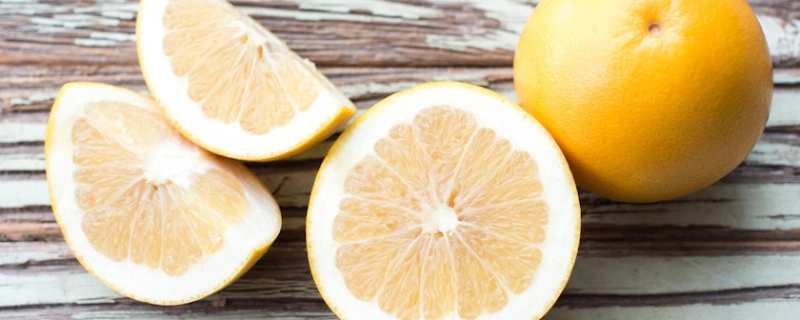
Nutritional Insights:
MeloGold fruits provide beneficial nutrients such as vitamin C, antioxidants, dietary fiber, potassium, and flavonoids. Regular consumption supports immune function, enhances iron absorption, promotes digestive health, and offers cardiovascular benefits due to antioxidants and potassium content. Its moderate sugar content makes MeloGold a healthy alternative to sweeter citrus fruits, suitable for balanced diets and weight management.
Expert Insights & Culinary Tips:
- Flavor Pairings: MeloGold pairs perfectly with avocado, seafood, fresh herbs (mint, basil, cilantro), leafy greens, honey, and mild cheeses.
- Preparation Recommendations: Enjoy MeloGold segments fresh, ideally chilled, to emphasize their sweetness and juiciness. Its juice adds refreshing sweetness to dressings, marinades, and beverages.
- Peel and Pith Management: Although significantly less bitter, avoid including excessive pith when using zest to maintain optimal flavor.
Interesting and Curious Facts:
- MeloGold was developed at the University of California, Riverside, specifically bred to improve sweetness and reduce grapefruit’s bitterness, thus appealing to consumers sensitive to bitter flavors.
- Its name, "MeloGold," references its melon-like sweetness and attractive golden-yellow color.
- Despite initial niche market appeal, MeloGold has become increasingly popular among citrus enthusiasts due to its flavorful yet mild profile.
Harm and Dietary Considerations:
MeloGold is generally safe for consumption, though its moderate acidity may irritate sensitive individuals if consumed excessively. Individuals allergic to citrus fruits should exercise caution. Moderate consumption during pregnancy is considered safe.
Religious Dietary Considerations:
MeloGold has no dietary restrictions within major religious dietary frameworks, including Halal, Kosher, Hindu vegetarianism, and Buddhist dietary practices, making it universally acceptable.
Final Thoughts & Sensory Journey:
MeloGold invites exploration through its gentle sweetness, pleasantly mild tartness, and refreshing aromatic character. Providing both nutritional richness and culinary versatility, MeloGold is an appealing citrus hybrid perfect for those seeking a delightful, flavorful, and less bitter alternative to grapefruit.
Resources:
- "The Citrus Industry" by Walter Reuther, Herbert J. Webber, and Leon D. Batchelor (University of California Press, 1989)
- "Citrus Fruit: Biology, Technology and Evaluation" edited by Milind Ladaniya (Academic Press, 2008)
- "Tropical and Subtropical Fruits: Postharvest Physiology, Processing and Packaging" by Muhammad Siddiq (Wiley-Blackwell, 2012)
